Soil Types and Site Preparation
Geraniums can be grown in a wide variety of soils. Ideal soil types should be rich in organic matte and have a pH of between 5.5 and 6.5 Good drainage is required to prevent water logging and reduce the incidence of root diseases. Before planting, plow the site, allowing weeds to develop before spraying with glyphosate. After weeds are killed, apply farmyard manure (20 to 50 tons per hectare) and basal inorganic fertilisers. Re Plough the site and prepare beds. Vegetative, it is propagated to maintain desired flower and/or leaf colour, shape and scent. Geranium seeds have a very hard seed coat which can inhibit germination, Geranium After roots are formed, place cuttings in full sun and water only enough to keep the cuttings from shriveling. Keep the surface soil dry to reduce diseases. Fertilise with a water-soluble fertilizer every two weeks. Grow the young geraniums at 22°C during the day and 18°C at night. Most geraniums will flower in 95 to 110 days from germination.
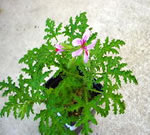
Planting
Geraniums should be planted in raised beds in the field at 30 cm spacing with 70 to 80 cm's between rows. At these spacing's, farmers will require approximately 50 thousand plants per hectare. For the first planting, high quality cutting of the Bourbon type should be obtained from Reunion. For subsequent plantings, use cuttings from existing strong and healthy plants. Cuttings can be directly planted in the field if they are large (30 cm in length), are taken from well established plants, and they are planted in fields with high moisture content to ensure survival. A sloping cut should be made just below the node and all leaves should be removed from the bottom half of the cutting. Alternatively, smaller cuttings (10-15 cm in length) can me made from a young shoot with 3 or 4 nodes and a terminal bud and placed with spacing's of 10 cm by cm in nursery beds that have been fertilised with NPK. Once the roots have begun to form, the shade can be gradually reduced. After 21 days, a weak liquid feed can be applied on a weekly basis. When the plants have developed good root system and obvious leaf growth (after about 40 days), the plants can be transplanted to the fields. During the life of the crop (3 to 4 years), gaps in plantings should be filled in with new plants. If the gap was caused by removal of diseased plants, the soil should be treated with 0.5% Bordeaux mixture (5 g/l). Do not use heavy clay garden soils which may not provide sufficient aeration. A mix of equal parts of garden soil, peat moss and perlite makes a good growing medium. A soil pH of 6.5 (mildly acid) is ideal, with poor growth occurring below pH 5.5.
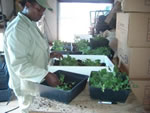
Proper fertilization of geraniums is of utmost importance. Geraniums respond well to fertilization and turn yellow in soils that lack a ready source of nitrogen. Make sure that organic matter added is well decomposed, or it may rob nitrogen from the geraniums as it decomposes. A garden fertilizer with a Nitrogen-Phosphate-Potassium (NPK) analysis of 5-10-5 or 6-12-12 applied at a rate of 0.9 to 1.4kgs per 9.3m2 (1 heaping teaspoonful per m2) is recommended before planting. Through the growing season geraniums require fertilization every 4 to 6 weeks. Apply 10-10-10 or 8-8-8 at the rate of 0.9kg per 9.3m2. Choose a fertilizer with a slow-release form of nitrogen to guard against leaching of nitrogen during heavy rains, which may damage ground and surface water quality, and to ensure a steady supply of nitrogen to the growing plants.
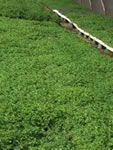
Transplant geraniums after all danger of late frost has passed in your area. Geraniums are easy to transplant and establish quickly after soils are warm in the spring. If bedding plants have a heavy, dense root ball, knock the potting mix out and break up the root ball before planting. Break up or remove peat pots, never letting the peat pot extend above the soil surface, as this wicks water away from the roots. Mulching with straw, bark chips or shredded hardwood bark mulch is recommended to conserve water in the soil and prevent splashing of soil onto plants during heavy rains, which may spread disease organisms. Apply mulch after the soil warms in the spring. A 2.6 to 5.1 cm layer of mulch is adequate to reduce high soil temperatures during the summer, prevent soil crusting, improve aeration and reduce weed growth. Geraniums need to be watered sufficiently to prevent wilting in the landscape. Soaker hoses and drip irrigation are the best for water conservation and to keep water off of the foliage, which contributes to disease problems. If using overhead irrigation, water early enough in the day to allow leaves and flowers to dry before nightfall, which will help prevent disease problems. Plant cuttings, whether long ones planted directly to the field or short ones reared in a nursery, will require moist soils in order to encourage root formation. Once plants are established, however, water logging should be avoided to prevent incidence of root disease. The plant requires reasonable amounts of moisture to maintain the thick leaves.
DISEASE PROBLEMS
Bacterial leaf spot/blight (Xanthomonas campestris pv. pelargonii)
- causes spotting of the leaves, leaf drop and black rot of the stems. The disease is favoured by warm, humid weather, crowding of plants and planting infected stock. To control, pick off and discard all leaves with spots. Avoid splashing water around plants. Watering by soaker hose to keep plants dry, watering in the morning so foliage can dry off, and sprays of copper fungicides are effective.
Alternaria leaf spot (Alternaria tenuis)
- a fungal leaf spot resembling bacterial leaf spot. The control measures are the same as for bacterial leaf spot.
Black leg (Fusarium sp.) and black stem rot (Pythium splendens)
- occur on cuttings and occasionally on full grown plants. The rot starts at the base of the cutting and progresses upward, blackening the stem and defoliating the plant. To control, take cuttings only from healthy plants which have been kept dry, root in sterilized rooting medium, and employ sanitation with a bleach solution to sterilize cutting tools and flats. Fungicidal drenches may help control the spread from plant to plant.
Botrytis gray mould, leaf spot and blossom light (Botrytis cinerea)
very common during cool, moist weather. Water soaked lesions occur first, which later dry out and are covered with a greyish brown mass of fungal growth. When the petals are infected they become discoloured, wilt and fall off. To control, remove old flowers and do not crowd plants in the landscape to insure good air circulation. Plant in full sunlight, keep plants on the dry side, and use fungicidal sprays if the disease is severe.
Rust (Puccinia pelargonii-zonalis)
causes powdery, golden brown pustules on the leaves, petioles and stems. The leaves turn yellow and drop prematurely. To control, avoid purchasing infected plants, and spray with fungicides if the disease is found in the landscape.
Virus diseases
can be transmitted from infected mother plants to cuttings made from these stock plants. Although at one time of commercial importance, virus-indexing has removed viruses from stock plants and viruses are no longer commonly seen. To control, discard any plants with virus-like symptoms such as mosaic, distortion or leaf spots, and practice sanitation when propagating cuttings.
Root-knot nematodes
- may cause galls and swellings on the roots, with stunted plant growth and death. To control, destroy infested plants, rotate planting areas and never re-plant in known infested areas. Geraniums should be planted in pots of sterilised soil if the infestation is severe.
Oedema or dropsy
a physiological problem that occurs during the winter, when plants are over-watered indoors. Water-soaked lesions develop when later become corky and rust coloured. Reduce watering and increase the light levels to control this problem.
Aphids
- frequently infest geraniums. Encourage beneficial predators, such as lady bugs and syrphid flies; spray with horticultural oils such as Sun spray oil; spray with insecticide soap such as M-Pede.
Caterpillars
such as the cabbage looper, the fall cankerworm, leaf rollers and leaf tiers may infest geraniums. Caterpillars can be controlled with sprays of Bacillus thuringiensis (Dipel, Bt).
Greenhouse whitefly
very problematic and may come into the garden on infested plants. Infested leaves turn yellow and fall; small, snowy white flies are seen on the undersides of the leaves; and a black sooty mould may be seen growing on the sugary whitefly excrement on the upper leaf surface. Control with sprays of insecticide soap, horticultural oils or currently recommended insecticides. Never purchase plants with whitefly infestations.
Mites
can cause young leaves to appear scorched, then curl and drop off. Control with sprays of insecticide soap, horticultural oils and currently recommended miticides.
Subterranean termites
may attack landscape or pot grown geraniums, where they tunnel through the stems and cause the plants to wilt, turn yellow and die. Clean out infested pots or planting beds, destroy any visible termite tunnels, and treat the soil with a recommended insecticide to kill the termites. Check for termite tunnels on the foundation of the house, and take care that termites do not travel from foundation plantings into the structure of the house.
Slugs
may be problematic; they can be trapped with saucers of stale beer.
PESTS AND DISEASE PREVENTION
Fusarium root rot and anthracnose leaf blight are the most widespread diseases in geranium. Root rot is caused by waterlogged soils, which should therefore be prevented. Plants with root rot will wilt; they should be removed from the field and the soil should be treated with a drench of 0.5% Bordeaux mixture (5 g/l). Anthracnose leaf blight generally occurs during the rainy season and mostly affects full grown plants. Spray with captan (0.2-0.5% ai) on a monthly basis during the rainy season as a preventive measure. Insect pests are not generally a major problem. If insects become a problem, spray dimethoate (845 ml in 500litres of water per ha) at two weekly intervals. However, does not use dimethoate if harvest is within 6 weeks; instead use a contact insecticide.
Herbicide Tolerance
For current weed control recommendations, consult the county Agricultural Extension Agent, and always follow label directions. Geraniums are tolerant to the herbicides bensulide (Betasan), DCPA (Dacthal), napropamide (Devrinol) and oryzalin (Surflan) when applied over the top of established plants for pre-emergence control of broadleaf and grassy weeds. For post emergence control of grassy weeds, fluazifop (Fusilade DX) and sethoxydim (Vantage) can be applied over the top of established geraniums in the landscape.
With a central processing line, smallholder's can grow geranium on 0.5 hectares, harvest the foliage which can be distilled by a trader for export. An individual producer would need to devote a minimum 7 hectares to producing geranium in order to meet minimum volume requirements for export sales.
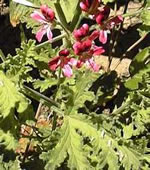
Time to First Harvest/Seasonality
The first harvest is normally 4 to 6 months after planting. Subsequent harvesting intervals are every 3 to 4 months (3 or 4 annual crops). However, it might be possible in Uganda's climate to harvest geranium almost continuously over 10 months on a block rotation system and, thereby, achieve a high rate of distillery capacity utilization.
Fertilizer Requirements
In addition to an initial application of manure and a basal inorganic fertilizer before planting, fertiliser should be applied after each harvest. Plant residues from the distillery can be reapplied to the field as mulch. Annually, a standard basal dressing of N (30 kg/ha), P (35 kg/ha), K (25 kg/ha) should be applied. Additionally, eight equally split top dressing of 25 kg/ha N should also be applied annually with recommended timing as follows:
- Before the 1st cut two doses
- Immediately after the 1st cut one dose
- Two weeks after 1st cut one dose
- Immediately after the 2nd cut one dose
- Two weeks after the 2nd cut one dose
- Immediately after the 3rd cut one dose
- Two weeks after the 3rd cut one dose
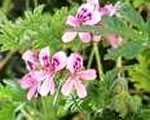
Harvesting
Harvesting is done 3 to 4 times per year (beginning 4 to 6 months after the first planting). Actual time of harvesting is dependent on the stage of plant growth (there is a large amount of new growth but not too many old stems) and the scent of crushed leaves (should turn from a lemony to a rose scent). Only leaves and young shoots should be harvested as this is where most oil is located; older stems should be cut off and left in the field. Harvesting is done by hand and should only be done on a dry day. Harvesting wet plants will cause poor oil recovery during distillation. When there is enough new plant, the one remaining branch may be cut.
Distillation
Small stills are move convenient even for relatively large farms (where they can be strategically located) because of the cost of moving large amounts of geranium foliage around. In Uganda, the most appropriate size still would be 1,000 litres in size. This size still would have the capacity to handle about 300kgs of foliage (actual amount depends on degree of wilting) and can process 1.2 tons per day (4 x 300kgs). One still of this type is needed for each 2 hectares (167 days of processing). Distillation of fresh plant cuttings must be done within a day or two of cutting. The cuttings may be left to wilt in the field for 24 to 48 hours to allow for better vaporisation of oil during distillation and greater packing of biomass in the still vessel. The still should be packed tightly to the top of the vessel. Loosely or partially packed stills will result in poor oil recovery.
Yield
The maximum oil yield is generally achieved in the second year. Geranium oil yield under Ugandan conditions should be 30-50kgs per hectare per year. This yield would be from three annual harvests producing a total vegetative yield of 25 tons per hectare. This is equivalent to a 0.2 percent recovery rates.
Product Specifications
Normal shipment sizes are 1 to 5 tons. Possible, short-term minimum size shipments for a new produce with an interested buyer are 0.25 to 0.50 tons. The species of the geranium is very important to the quality of the product. A different species is like introducing a completely new product, which would take a lot of time. The product is differentiated by its odour profile and chemical composition. The chemical make-up is determined by soil, rainfall, fertilizer, distillation techniques, etc. There are published specifications that would need to be followed for the production of geranium oil.
Packaging
Geranium oil is typically packed in 200 litre/180kg steel (preferably galvanised) drums. It is occasionally packed in 40-90 kg aluminium drums. The drum should be labeled with the name of the product, the country of origin, and the weight of the contents.
Geranium essential oil
The pale green essential oil is steam distilled from the fresh flowers, stalks and leaves. The plant should be cut just before the flowers open and between 300 and 500kg of plant material is required in order to obtain about 1kg of essential oil. Most of the essential oil glands are found in its leaves. After cutting, the plants are partially dried to increase the yield of oil leaving less water to be vaporized and extracted from the plant material during the distillation. The essential oil in rose geranium leaves has the constituents, geraniol, linalool and citronellol, which are also present in rose oil. The well-balanced aroma of geranium's fragrance resembles that of rose with a musty, mint-green undertone. Geranium oil has been described as a natural perfume complete unto itself. It is often used to scent soaps and detergents because, unlike many other essential oils, rose geranium's aroma profile is not readily affected by the alkaline nature of soap products. Rose geranium varies much across strains and distillations, in part because the plant is greatly influenced by the climate and soil in which it grows. Geranium oil can range from very sweet and rosy to musty, mint and green.

 Proud to be
Proud to be